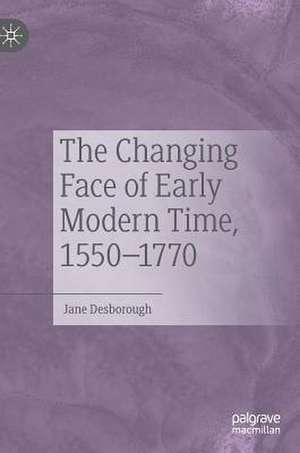The Changing Face of Early Modern Time, 1550–1770
Autor Jane Desboroughen Limba Engleză Hardback – 10 apr 2019
Preț: 592.44 lei
Preț vechi: 696.99 lei
-15% Nou
Puncte Express: 889
Preț estimativ în valută:
113.37€ • 121.22$ • 94.52£
113.37€ • 121.22$ • 94.52£
Carte tipărită la comandă
Livrare economică 18 aprilie-02 mai
Preluare comenzi: 021 569.72.76
Specificații
ISBN-13: 9783030153526
ISBN-10: 3030153525
Pagini: 257
Ilustrații: XV, 292 p. 36 illus., 31 illus. in color.
Dimensiuni: 148 x 210 mm
Greutate: 0.65 kg
Ediția:1st ed. 2019
Editura: Springer International Publishing
Colecția Palgrave Macmillan
Locul publicării:Cham, Switzerland
ISBN-10: 3030153525
Pagini: 257
Ilustrații: XV, 292 p. 36 illus., 31 illus. in color.
Dimensiuni: 148 x 210 mm
Greutate: 0.65 kg
Ediția:1st ed. 2019
Editura: Springer International Publishing
Colecția Palgrave Macmillan
Locul publicării:Cham, Switzerland
Cuprins
1 Introduction.- 2 Communication Methods.- 3 Trust and Distrust.- 4 Tools of Enablement.- 5 Calendrical Insight.- 6 Lunar Wisdom.- 7 Astronomical Knowledge.- 7 Conclusion.
Recenzii
“An extraordinary book in every way, exploring the changing use of clocks and watches offering new insights into early perceptions of time and its practical use. The book’s author … must be congratulated on the in-depth research that has led to a reinterpretation of early clock and watch dials on the basis of use. … This is a fascinating and compelling exploration of an extraordinary period of change for all aspects of life seen through the development of the watch and clock dials.” (MWM, mrwatchmaster.com, November 22, 2022)
Notă biografică
Jane Desborough is Curator of Scientific Instruments at the Science Museum in London, where she manages the museum’s Time Measurement collection. She has worked in a curatorial capacity in museums since 2008 and completed her PhD thesis in the History of Science in 2016. She is a Liveryman of the Worshipful Company of Clockmakers and an Associate Member of the Museums Association.
Textul de pe ultima copertă
‘‘In this compelling interdisciplinary book, Jane Desborough brings lucid academic analysis to explore the practical world of skilled craftsmanship. Focusing on Britain, but with extended European comparisons, she examines over 250 dials to reveal how their multi-functional appearance gradually evolved into a standard format... a brilliantly original and comprehensive approach.’’ Patricia Fara, President of the Antiquarian Horological Society and Emeritus Fellow, Clare College, University of Cambridge, UK
‘’By showing the ways in which the information conveyed by clock and watch dials changed over time, Jane Desborough’s excellent book reveals and explains the changing needs of their owners and therefore the underlying changes in society and culture. The result is eye-opening, enlightening, and continually fascinating.’’ John Henry, Professor Emeritus, University of Edinburgh, UK
This book provides a reinterpretation of early modern clock andwatch dials on the basis of use. Between 1550 and the emergence of a standard format in 1770, dials represented combinations of calendrical, lunar and astronomical information using multiple concentric rings, subsidiary dials and apertures. Change was gradual, but significant. Over the course of eight chapters and with reference to thirty-five exceptional images, this book unlocks the meaning embedded within these early combinations. The true significance of dial change can only be fully understood by comparing dials with printed paper sources such as almanacs, diagrams and craft pamphlets. Clock and watch makers drew on traditional communication methods, used different formats to generate trust in their work, and tried to help users in different contexts. The calendar, lunar and astronomical functions were useful as a memory prompt for astrology up until the mid-late seventeenth century.
‘’By showing the ways in which the information conveyed by clock and watch dials changed over time, Jane Desborough’s excellent book reveals and explains the changing needs of their owners and therefore the underlying changes in society and culture. The result is eye-opening, enlightening, and continually fascinating.’’ John Henry, Professor Emeritus, University of Edinburgh, UK
This book provides a reinterpretation of early modern clock andwatch dials on the basis of use. Between 1550 and the emergence of a standard format in 1770, dials represented combinations of calendrical, lunar and astronomical information using multiple concentric rings, subsidiary dials and apertures. Change was gradual, but significant. Over the course of eight chapters and with reference to thirty-five exceptional images, this book unlocks the meaning embedded within these early combinations. The true significance of dial change can only be fully understood by comparing dials with printed paper sources such as almanacs, diagrams and craft pamphlets. Clock and watch makers drew on traditional communication methods, used different formats to generate trust in their work, and tried to help users in different contexts. The calendar, lunar and astronomical functions were useful as a memory prompt for astrology up until the mid-late seventeenth century.
Caracteristici
Explores the changing use of clocks and watches from 1550-1770 to offer new insights into early modern perceptions of time Focuses on the design of dials, showing how their shifting functions and appearances are central to knowledge transmission during this period Considers the wider context of literature, emotion and temporality, connecting changing ideas about time with other aspects of early modern culture
